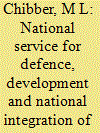|
|
|
Sort Order |
|
|
|
Items / Page
|
|
|
|
|
|
|
| Srl | Item |
| 1 |
ID:
130723


|
|
|
|
|
| Publication |
Oxon, Routledge, 2014.
|
| Description |
xvi, 243p.Hbk
|
| Standard Number |
9780415830683
|
|
|
|
|
|
|
|
|
|
|
|
Copies: C:1/I:0,R:0,Q:0
Circulation
| Accession# | Call# | Current Location | Status | Policy | Location |
| 057757 | 361.954/MIK 057757 | Main | On Shelf | General | |
|
|
|
|
| 2 |
ID:
006023


|
|
|
|
|
| Publication |
Meerut, Kartikeya Publications, 1995.
|
| Description |
x, 272p.
|
| Standard Number |
8185823073
|
|
|
|
|
|
|
|
|
|
|
|
Copies: C:1/I:0,R:0,Q:0
Circulation
| Accession# | Call# | Current Location | Status | Policy | Location |
| 036906 | 355.22363/CHI 036906 | Main | On Shelf | General | |
|
|
|
|
| 3 |
ID:
132962


|
|
|
|
|
| Publication |
Oxford, Oxford University Press, 2014.
|
| Description |
x, 309p.Hbk
|
| Standard Number |
9780199453627
|
|
|
|
|
|
|
|
|
|
|
|
Copies: C:1/I:0,R:0,Q:0
Circulation
| Accession# | Call# | Current Location | Status | Policy | Location |
| 057868 | 338.954/PAN 057868 | Main | On Shelf | General | |
|
|
|
|
| 4 |
ID:
087515


|
|
|
|
|
| Publication |
2009.
|
| Summary/Abstract |
The Indian state has been more penetrated by social actors than many
East and Southeast Asian states. Unlike China, India could neither
abolish private enterprise nor could it embrace globalization with the
same speed and ferocity. Both complete state-driven nationalization
and state-driven globalization would demand a state, which would
have much greater command over interest groups like industrialists,
farmers and trade unions. Policies favoring economic growth and
development in India needed to evolve gradually after building a
social consensus on those policies. This is a model of development
driven by a relationship between the state and society, where the
power of the state, even in its commanding moments, was moderated
by the power of social actors.
Developmental ideas were debated within the state. Substantial
economic policy change would require building upon a historical path
of gradual changes in ideas and policies, punctuated by economic crises.
This paper demonstrates how this dynamic is critical for explaining
the politics of the green revolution and consequent self-sufficiency in
food grains, as well as for understanding the India's globalization
beyond 1991. It is a story of getting to higher rates of economic
growth in a gradual and circuitous way after building a policy consensus
among diverse stakeholders. Economic crises aided the arrival of a
new consensus.
India's growth rates began looking more like China's after 2003.
Figure 1 gives us a visual feel of the trajectory of India's growth.
Between 1956 and 1974, India's GDP grew between 3 and 4 percent
per annum, when it was a closed and highly regulated economy.
|
|
|
|
|
|
|
|
|
|
|
|
|
|
|
|
|
|
|
|
|